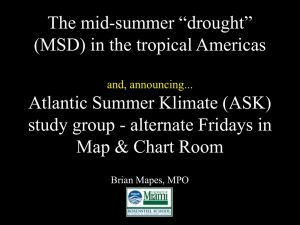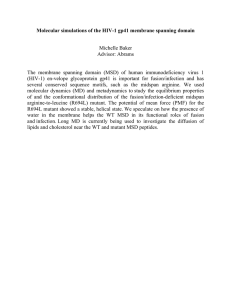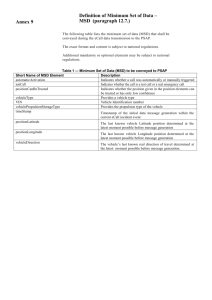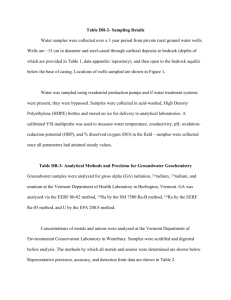Simpler Central American mid-summer drought (MSD)
advertisement
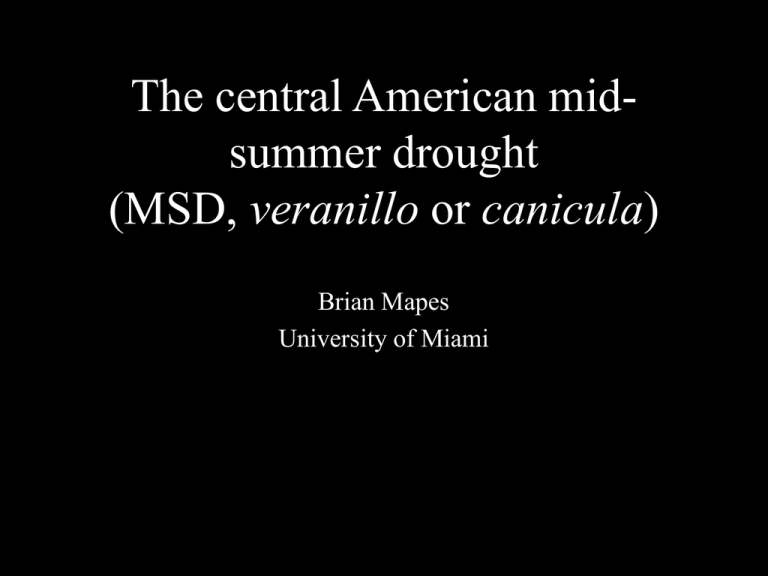
The central American midsummer drought (MSD, veranillo or canicula) Brian Mapes University of Miami midsummer drought 30-year climatology Miami Key West 1999 MSD ( ? What causes the MSD? • Local, fussy: – The ingredients for convection get worse (moisture, instability, lifting mechanisms). • Global, vague: – Solar declination angle ultimately drives all aspects of the seasonal cycle. – Continent-ocean contrasts involved • Somewhere in between lies a useful truth...A What causes the MSD? • Regional: – North Atlantic Subtropical High (NASH or Bermuda High) & tradewinds are enhanced and extended west in mid-summer. Midsummer nose on N. Atlantic Subtropical High (NASH) Veracruz Cayman late Mayearly June Valparaiso wet dry July wet upwind slopes wetter in midsummer Valparaiso, FL midsummer drought Miami Key West Cayman MSD broader in time than Veracruz CMAP Individual years - still discernable (in big regional Central American box average) intraseasonal can mask it a bit 9 year mean TAIWAN 25N MSD happens in other places too May CUBA 25N May SE BRAZIL 25S Nov. MADAGASCAR 25S CMAP rainfall Nov. Where are those boxes? W. subtropical oceans High igh High High What causes the MSD? • Regional: – NASH (Bermuda High) & tradewinds are enhanced and extended west in mid-summer. • Locally, less rain is due to: – – – – – frictional divergence or other subsidence mech.? flow direction brings drier airmass? wind leads to lower SST (albeit via enhanced LHF)...? capping inversion strength/height? different meso/synoptic disturbance characteristics? • But what causes the NASH/trades to vary? A broader view of the summertime oceanic subtropical highs • Meteorology 101: – Hot air rises, cool air sinks. • Hydrostatic sinking is all about PGF to push horizontal branch of circulation (divergence) • e.g. Hadley cell: eq. trough, subtropical H belt • In summer, subtrop. oceans cooler than land =>Highs over the ocean basins Annual mean SLP July SLP (same color scale) cooling cooling January SLP (same color scale) • Meteorology 301: stratified – Heated air rises, cooled air tends to sink. • heating rate = rate of flow across isentropes = vertical velocity (in coordinates) – E. subtropical oceans: cooling (even in winter) • little latent heat release (rain), much rad. cooling (stratocu decks under dry upper troposphere) “The Usual Explanation” • Hoskins (1996): • “the usual explanation for the subtropical anticyclones (radiative cooling)” in summer is “inadequate” • “monsoon latent heat release over the neighboring continent” is essential 2001 Model experiments, forced by realistic heating (above), in realistic JJA zonal mean flow, with real topography Rodwell and Hoskins 2001 Asian Heating Q_Asia Y887 (Q_Asia, mts) Pure heating effect: Y887 (Q_Asia, mts)Y887 (mts only) Rossby ?? Kelvin Try NAm and NPac Heating: Y887 forced by mountains + NAm Q Y887 forced by mtns + NAm Q + NPac Q Rossby ?? Kelvin Red: global Q Small et al. 2007 concur: imposed heating anomalies in the region can explain most of the flow anomalies • some westward influence from E. Atl • MSD negative heating drives NASH/trade enhancement • positive feedback positive feedback • Easterlies / High drive (negative) rain anomalies • (negative) latent heating anomalies drive easteries/ High • An amplified, twitchy system - but what drives it, to make this climatological feature? One hypothesis: One hypothesis: MSD wet midsummer tradewind surge Drivers: 2. Mean flow changes in midsummer? Chen, Hoerling & Dole 2001 Heating Eddy Z1000 w/o shear Eddy Z1000 July u(y,p) u300, zonal mean Jul-Aug time slice 60N Westerlies retreat to >30N in midsummer Qu i ck Ti me ™a nd a T IF F (LZ W )d ec om pres so r ne ed ed to s ee th i s pi c tu re. <0 Eq J F M A M J J A S O N D time slice easterlies protrude to 30N suddenly in mid summer WHY, in terms of [u] budget? • Not f[v]: ~barotropic; [v](t) wrong • [u’v’]: Tilted TUTTs, Tibetan High, Transients? Drivers: 3. Influences via the midlatitude westerlies? 2006 Hudson Bay contributes too west coast thermal gradient Japan’s midsummer drought mechanism: the Bonin High “Formation mechanism of the Bonin High in August” (Enomoto, Hoskins, & Matsuda 2003) QuickTime™ and a TIFF (LZW) decompressor are needed to see this picture. positive feedback • An amplified, twitchy system - what drives it, to make this climatological feature? 1. Local SST cycle hypothesis? – not well supported by obs 2. Global easterlies in midsummer? – but where do they come from? 3. Midlatitude wave pathways? 4. Asian monsoon? – via Rodwell-Hoskins’ wraparound Kelvin wave? Clues from climate models • Do free-running, full-physics climate models have the MSD? – Short answer: yes • What drives it there? – Global, vague: • solar declination, like all aspects of seasons • continent-ocean contrasts • Experiment! 5 Observations CMAP rain 1 SLP July Aug IPRC/ ECHAM model: quite good 8 IPRC GCM rain 2 GCM SLP Experiment: global monsoon system on steroids • Increase continent-ocean contrasts – perpetual June (and every other month): • fix SST and solar decl. for each day of year • run model for many days, so atm+land come into equilibrium – Warmest NH now in June, not July – Continents hotter in summer (dried out?) – What happens to monsoons (and MSD)? Northern continents get hotter in summer Dec Jan Our MSD is a major part of the global rainfall response Annual mean rainfall change Americas drier Indian Ocean wetter Dec in MSD Jan early onset Conclusions (so far) • The Central American MSD is a significant aspect of the seasonal cycle, both regionally and globally. • Useful for understanding phys. mechanisms – how exactly does the NASH affect rainfall/convection • U. for u. summer teleconnections – from Asia, zonal [u] easterlies, waves on westerlies... • A “natural mode” of the regional system - relevant to other types of S-I climate variability? Future work • Starting fall 07 in earnest (thanks NSF) • Atlantic summer climate reading group – me, 2-3 students on project, other experts (please!) • where to start? software demo u200 HF anomaly plot, July-Aug HF anomalies (total - annual - semiannual): Yes, the Bonin High and 2 other stationary waves are evident, but also a zonally elongated u anomaly spanning all Asia-WPAC Japan -4 -2 HF 0 m/s 2 time slice Jul Aug 10d 100d HF wavelet analysis Interannual consistency of the Asian HF jet anomaly ~1 Aug Low-level heating dominant. Influences from monsoons and planetary waves, but mainly local feedbacks. Eastern-basin oriented. EASM ISM ENASM? EASM NAM WNPM (2nd active) May 1 Jun 1 Jul 1 May 1 Jun 1 Jul 1

